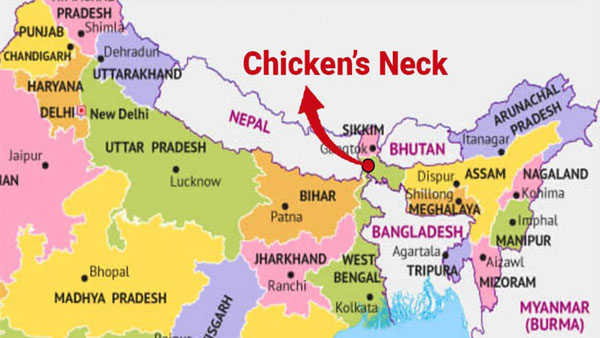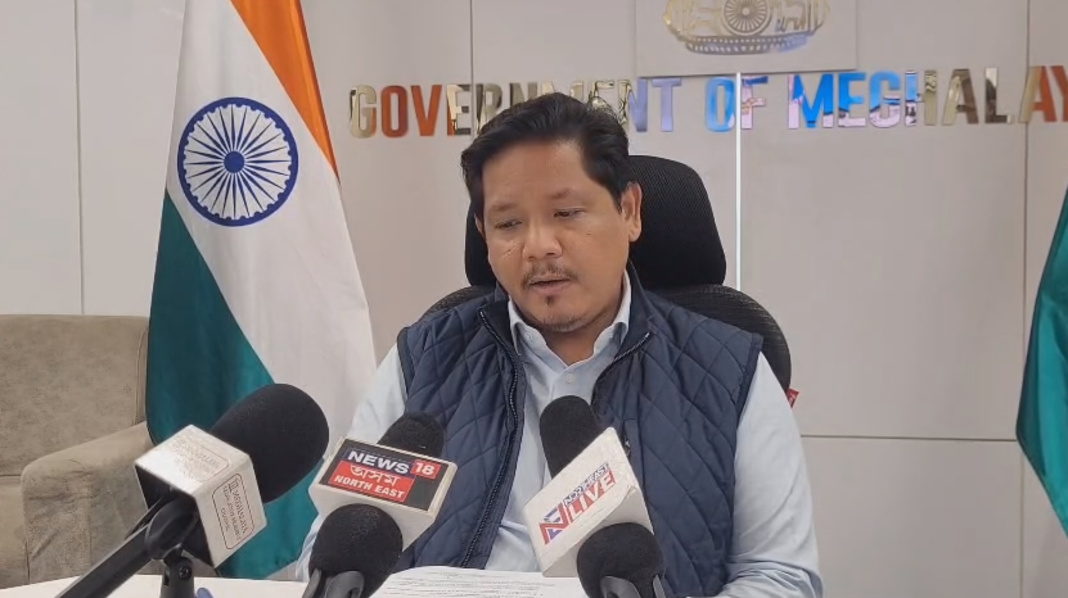By Dipak Kurmi
In the geography of nations, there are certain places where the fate of millions seems to hang by a fragile thread of land. For India, this thread is the Siliguri Corridor—an exceptionally narrow, 22-kilometre-wide strip that holds together the vast expanse of the mainland with its remote northeastern states. Known evocatively as the “Chicken’s Neck,” this corridor has over time become both a symbol of strategic vulnerability and an anchor of resilience, reflecting the intersection of history, demography, and geopolitics in ways that are as perilous as they are profound.
The origins of this narrow passage lie in colonial decisions and the tumult of partition. When the British Empire carved and divided South Asia in 1947, Bengal’s fragmentation and the creation of East Pakistan left India with a constricted lifeline to its northeastern frontier. What was once part of the unified Koch kingdom under Naranarayan and Chilarai—inhabited by Koch-Rajbangshi people—was now reduced to a geopolitical chokepoint, its very existence defined by accidents of history. The corridor snakes across the northern part of Bengal’s Uttar Dinajpur district and the southern edge of Darjeeling district, pinched between Nepal to the west, Bhutan to the north, and Bangladesh to the south. That it alone connects the populous and resource-rich northeastern states with the mainland underscores its enormous significance for India’s economy, defence, and identity.
From the outset, the vulnerabilities of the corridor were evident. Former Deputy Chief of Staff of the Indian Army, General (Retd) S.K. Sinha, in his 1998 report to the President of India, warned gravely of the dangers that could arise if hostile forces sought to sever this lifeline. He highlighted the “long-cherished design of a Greater East Pakistan/Bangladesh,” which, if successful, would isolate the Northeast with all its immense resources from the rest of India. His foresight was not misplaced, for in the decades since, the corridor has remained at the centre of strategic anxieties, occasionally jolted into prominence by regional crises and the shifting sands of geopolitics.
The Doklam standoff of 2017 was one such moment when this geographical vulnerability was laid bare. China’s attempt to extend a road into the tri-junction area between India, Bhutan, and China brought the corridor into sharp strategic focus. A mere 130 kilometres from the Chicken’s Neck, the Doklam plateau demonstrated how China’s steady infrastructure build-up in Tibet could translate into coercive leverage over India’s most sensitive chokepoint. Though the 73-day confrontation ended without open conflict, it underscored the urgency of fortifying the corridor. India responded with enhanced troop deployments, widened highways, upgraded railways, and high-tech surveillance, yet the uncomfortable truth remained—no infrastructure can fundamentally alter the corridor’s inherent fragility.
Recent developments, however, have added even more troubling dimensions. Bangladesh, once a nation bound to India by shared sacrifices of the 1971 Liberation War, appears increasingly ambivalent in its strategic orientation. The interim leadership under Muhammad Yunus has, whether by design or under pressure from radical forces, sent disquieting signals. His reference during a China visit to India’s Northeast as “landlocked,” implying its dependence on Bangladesh’s goodwill, was not merely a geographical observation but a veiled geopolitical reminder. Soon after, retired Bangladeshi Major General ALM Fazlur Rahman openly suggested that in the event of a conflict between India and Pakistan, Bangladesh could seize the opportunity to “occupy the seven northeastern states,” even floating the possibility of a joint military alignment with China. Though officially disowned, his words resonated as echoes of latent hostility within segments of Bangladesh’s strategic elite.
These statements gain sharper menace when viewed against the backdrop of China’s rising presence in Bangladesh. Beijing’s plans to develop the Lalmonirhat Airport, barely a short distance from the corridor, may be framed as civilian infrastructure, but its dual-use military potential cannot be ignored. With its investments in the China-Pakistan Economic Corridor on one flank and Tibet’s militarisation on another, China’s interest in embedding itself into Bangladesh’s geography suggests a tightening noose around India’s northeastern artery. The Chicken’s Neck, thus, is increasingly at risk of being encircled in a strategic triangle where Beijing and Dhaka, if aligned, could complicate India’s security calculus dramatically.
But the threats are not merely external. Internal fissures also play into this dangerous equation. The demographic transformations in the Siliguri region and adjoining districts of Bengal and Assam over the past five or six decades, largely driven by cross-border migration, have altered the sociopolitical fabric. Many who fled East Pakistan during the Bangladesh Liberation War settled permanently in the region, amplifying pressures on land, resources, and identity. Radical groups have seized upon these shifts, working to instill anti-India sentiments and create disaffection with the state. The rhetoric of Sharjeel Imam, who during the protests against the Citizenship (Amendment) Act suggested that cutting off the Siliguri Corridor could paralyse the Indian state, exemplifies how domestic radicalism and external geopolitics can intersect in disquieting ways.
The Indian state, aware of these converging pressures, has sought to respond with a layered approach. Military readiness remains the cornerstone, with the Eastern Command stepping up exercises, logistics planning, and infrastructure enhancement. Highways and rail lines through the corridor are now designed for dual use, enabling both civilian mobility and rapid military deployment. Sophisticated surveillance systems track movements across the northern and southern borders, while airlift capabilities ensure that reinforcements can be flown in if required. Yet military might alone cannot secure the corridor; diplomacy and deterrence must walk hand in hand.
Assam Chief Minister Himanta Biswa Sarma’s recent warning to Bangladesh highlighted precisely this duality. By reminding Dhaka of its own vulnerabilities—the narrow 80-kilometre Rangpur Corridor linking northern Bangladesh and the 28-kilometre Chittagong Corridor connecting its economic heart—he signalled that any adventurism against India’s Chicken’s Neck could invite retaliation that cripples Bangladesh’s lifelines. His words, though carefully framed as geographical truths, carried a calculated deterrent message: India may be vulnerable, but so too is Bangladesh.
Such signalling, however, requires careful calibration. Heavy-handed coercion risks pushing Dhaka further into Beijing’s embrace, while excessive softness could embolden anti-India narratives within Bangladesh. The challenge for New Delhi is to preserve its vital security interests while sustaining economic and cultural engagement with Dhaka. India remains one of Bangladesh’s largest trading partners and a crucial provider of transit, power, and infrastructural assistance. Leveraging this interdependence prudently offers India a way to temper Bangladesh’s strategic drift without overt confrontation.
The stakes are high, for the corridor is more than a military concern. It carries the economic lifelines of over 45 million citizens of the Northeast, including trade routes, energy pipelines, and digital connectivity. It is also the pathway for India’s Act East policy, which envisions the Northeast not as a periphery but as a gateway to Southeast Asia. If the corridor were compromised, the ripple effects would not only fracture India’s territorial unity but also stall its economic and diplomatic outreach eastward.
Strategic thinkers like Brahma Chellaney and C. Raja Mohan have long warned that India risks encirclement by a triad of adversarial forces: Pakistan in the west, China in the north, and a potentially hostile Bangladesh in the east. The Siliguri Corridor sits at the intersection of these anxieties, making it the most critical keystone in India’s geopolitical architecture. Securing it is not just about defending a strip of land but about defending the idea of India as a contiguous and unified nation.
History has shown that narrow chokepoints often decide the fortunes of nations. The Khyber Pass defined empires in South Asia, the Bosphorus determined the fate of Byzantium, and the Malacca Strait continues to shape Asian trade. For India, the Siliguri Corridor belongs in this category of geostrategic chokepoints whose significance transcends geography. It is simultaneously an artery of connectivity and a potential fracture line. How India navigates its defence, diplomacy, and domestic management of this corridor will determine not just the security of its Northeast but also the credibility of its regional power status.
Ultimately, the Chicken’s Neck embodies both India’s Achilles’ heel and its test of resilience. To secure it is to affirm that the unity of the Indian state is beyond negotiation, that while peace is sought with neighbours, sovereignty will not be compromised. It is a reminder that geography may constrain, but it also compels nations to innovate, adapt, and strengthen their resolve.
As India fortifies its defences, balances its diplomacy, and deepens its engagement with the Northeast, the Siliguri Corridor remains the nation’s most visible expression of both vulnerability and strength. It is here, in this narrow passage between mountains and plains, that the great game of South Asian geopolitics converges—and it is here that India must ensure the Chicken’s Neck does not become the fracture that adversaries hope for, but rather the backbone that sustains its rise.
(the writer can be reached at dipakkurmiglpltd@gmail.com)




